









Copyright 2009-2014 Mahavir Gems. All Rights Reserved.
MAHAVIR GEMS

Amethyst
Amethyst is the birthstone for the month of February & the anniversary gemstone for the 6th year of marriage.
Amethyst is a purple color gemstone. The legend of the origin of amethyst comes from Greek myths. Dionysius, the god of intoxication, was angered one day by an insult from a mere mortal and swore revenge on the next mortal that crossed his path, creating fierce tigers to carry out his wish.
Along came unsuspecting Amethyst, a beautiful young maiden on her way to pay tribute to the goddess Diana. Diana turned Amethyst into a statue of pure crystalline quartz to protect her from the brutal claws. Dionysius wept tears of wine in remorse for his action at the sight of the beautiful statue. The god's tears stained the quartz purple, creating the gem we know today.
Amethyst - Important Characteristics
- Classification
- Hardness (Mohs Scale)
- Chem. formula
- Composition
- Crystal Structure
- Colour
- Atomic (Crystal )Structure
- Index of Refraction
- Density (Relative)
- Luster
- Uses
: Mineral
: Seven (7)
: SiO2
: Silicon Dioxide
: Granular Mass.
: Pale lilac to deep purple.
: Hexagonal (Trigonal)
: 1.544 - 1.553
: 2.65
: Vitreous
: Jewelry, decorative art, ornaments.
Purple color has long been considered a royal color so it is not surprising that amethyst has been so popular throughout history.
Amethyst, transparent purple quartz, is the most important quartz variety used in jewelry. Amethyst was thought to encourage celibacy. Because of that, amethyst was very important in the ornamentation of churches in the Middle Ages. Bishops still often wear amethyst rings.
In Tibet, amethyst is considered to be sacred to Buddha and rosaries are often fashioned from it.
The Greek work "amethystos" basically can be translated as "not drunken."
Amethyst was considered to be a strong antidote against drunkenness, which is why wine goblets were often carved from it! The gemstone still symbolizes sobriety.
Amethyst ranges in color from pale lilac to deep purple. The pale colors are sometimes called "Rose de France" and can be seen set in Victorian jewelry. The deep colors are the most valuable, particularly a rich purple with rose flashes.
Amethyst is available in a wide range of calibrated sizes and shapes, including many fancy shapes. Large fine stones may be sold in free sizes but generally amethyst is cut in standardized dimensions.
Amethyst accounts for the most attractive phanerocrystalline variety of quartz. Shades of colour ranges from bluish violet to purple. Some deeply coloured opaque stones appear almost black. Colour zoning is common in amethyst which may be in straight bands, tripartite sector or in irregular zones.
Occasionally amethyst core may be enveloped by uncoloured or smoky quartz or vice versa, resembling phantoms. Amethyst occurs as well developed crystals. Colour causing impurity is Fe2O3 present in the range of O.O1% and in the darkest varieties it may go upto 0.35% (Frondel, 1962). The presence of Fe3+ will not result in violet colour, but it acts as the hole centre precursor (Nassau, 1994). Replacement of Si4+ by the trivalent iron produces [FeO415- tetrahedral units which on irradiation in nature knocks out an electron from the outer orbit.
[(FeO4)5 - irradiation (Fe04)4 + e- ]
The vacant position created by the displaced electron accounts for the hole centre that absorbs yellow part of the spectrum and the resultant colour is violet. Violet colour is lost on heating.
Heating to 400°C-450°C converts amethyst to citrine and at 500°C-575°C colour is intensified to orange yellow to reddish brown. These are often called burned amethysts. On further heating the colour may be bleached giving rise to a milky opalescence (Frondel, 1962).
On irradiation, amethystine colour may be reinstalled and it can be reversed on heating to obtain pale citrine colour, but not those converted to deep yellow-orange brown citrine.
Some carefully heated stones produce a bicoloured ametrine, consisting of alternate sectors of violet and yellow colour. On controlled heating some amethyst from Minas Gerais, Brazil produce a green coloured quartz termed as prasiolite. The colour is due to the conversion of Fe3+ to Fe2+. Green quartz is synthesized by doping it with iron (Fe2+) in reducing atmosphere.
Amethyst is mined in India, Brazil, Uruguay, Bolivia and Argentina and some African countries. Generally, amethyst from South America tends to be available in larger sizes than African amethyst but amethyst from Africa has the reputation for having better, more saturated, color in small sizes. Very dark amethyst, mostly in small sizes, is also mined in Australia.
Indian Occurence
Large deposits of zoned, rather too dark and nearly opaque amethyst are found in the granitic terrains around Hyderabad city. Some of the localities in this region are Shemsabad, Palmcut, Nagumpally, Bekonenpett, Sadashivpett and Bowenpalle. Amethyst is also found in Medak Mehboonagar and Warangal areas in Andhra Pradesh. Fine amethyst is known to occur in Kangayam (11°00':77°34'),
Tamil Nadu. In Kerala it is found at Kollengode (10°37':76°41') and also at Mundur in Mysore district, Kamataka. It is however, difficult to record the sporadic occurrence of amethyst geodes in the DT terrain of Gujarat and Maharashtra.
In Orissa it is found in Maribahal-Tetalkunti in Bolangir district. In addition to the indigenous material, India imports rock crystal, amethyst and citrine from Brazil and African countries for faceting.
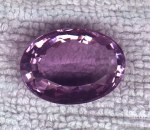
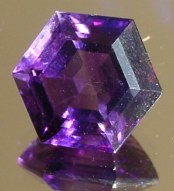
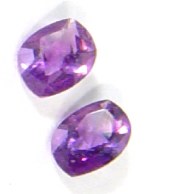
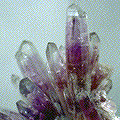
Amethyst Rough
(Quartz Group)
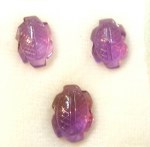
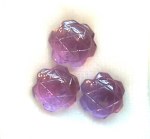
This site is best viewed on 1024 x 768 screen resolution using Mozilla 3.5 Browser
